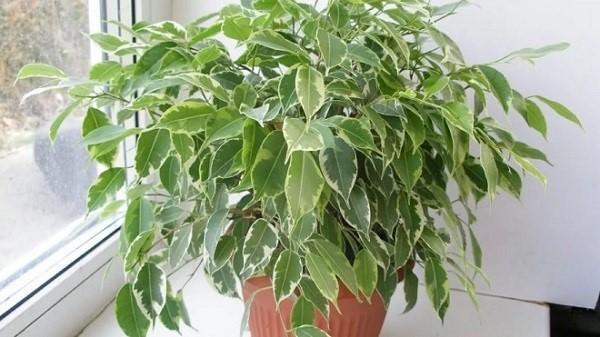We grow a miniature tree in the apartment - ficus Kinki
 One of the most decorative ficuses consider the Kinki variety - this is a variety of the known ficus benjamin... Such a plant received a large number of small leaves from its parent, but it differs from it in their variegated color and its more modest size.
One of the most decorative ficuses consider the Kinki variety - this is a variety of the known ficus benjamin... Such a plant received a large number of small leaves from its parent, but it differs from it in their variegated color and its more modest size.
The second name - variegated ficus - the flower received precisely because of the two-tone tone of the leaves.
On this topic: home care for Benjamin's ficus!
Description of the species
Ficus Kinki is a compact bush with a voluminous deciduous head. It branches well, and over time the shoots droop under the weight of a large number of variegated leaves up to 4 cm long. The main stem is straight, covered with dense wood.
There are two types of Kinki ficus:
- one has leaves with a white border around the edges;
- the second has a cream-colored rim.
In variegated ficus, the structure of the leaf plate is more rigid than that of Benjamin's ficus.
Care features
Variegated varieties of ficus do not tolerate waterlogging, therefore, when planting, good drainage must be laid on the bottom of the pot. It can be a layer of expanded clay. As for the soil, it must be nutritious. Ficus grows well in a common substrate for decorative foliage plants, which is sold in a flower shop. If desired, a little deciduous land is added to it.
With age, the main root of the Kinki ficus becomes thick, darkens and lignifies. This makes it possible to make bonsai from the plant. If you wish, you can simply leave such a powerful root above the soil surface when planting, without sprinkling it with earth. This will make the bush look more decorative.
When transplanting an adult plant, which should be done in the spring, roots that are too long can be trimmed.
Unlike ficuses with a solid color, Kinki requires good lighting, so the southern windows are just for him (provided that they do not open and there is no draft). But even there, there is a possibility that the flower will need illumination in winter, since the daylight hours during this period are very short. In addition, if the pot is directly on the windowsill, it is necessary to put a piece of polystyrene under it in winter - ficuses do not like it when they have "cold feet".
You can understand that the ficus lacks light by the elongated internodes and shoots. In addition, leaves fall unscheduled.
In summer, the flower should be watered regularly, as soon as the ground is dry on top. In winter, once a week is enough, while the lower the temperature in the room (but not less than 18 degrees Celsius), the longer the ficus can do without water.
A sharp yellowing of the leaves of the ficus indicates overflow, and their twisting and leaf fall indicate that it is cold.